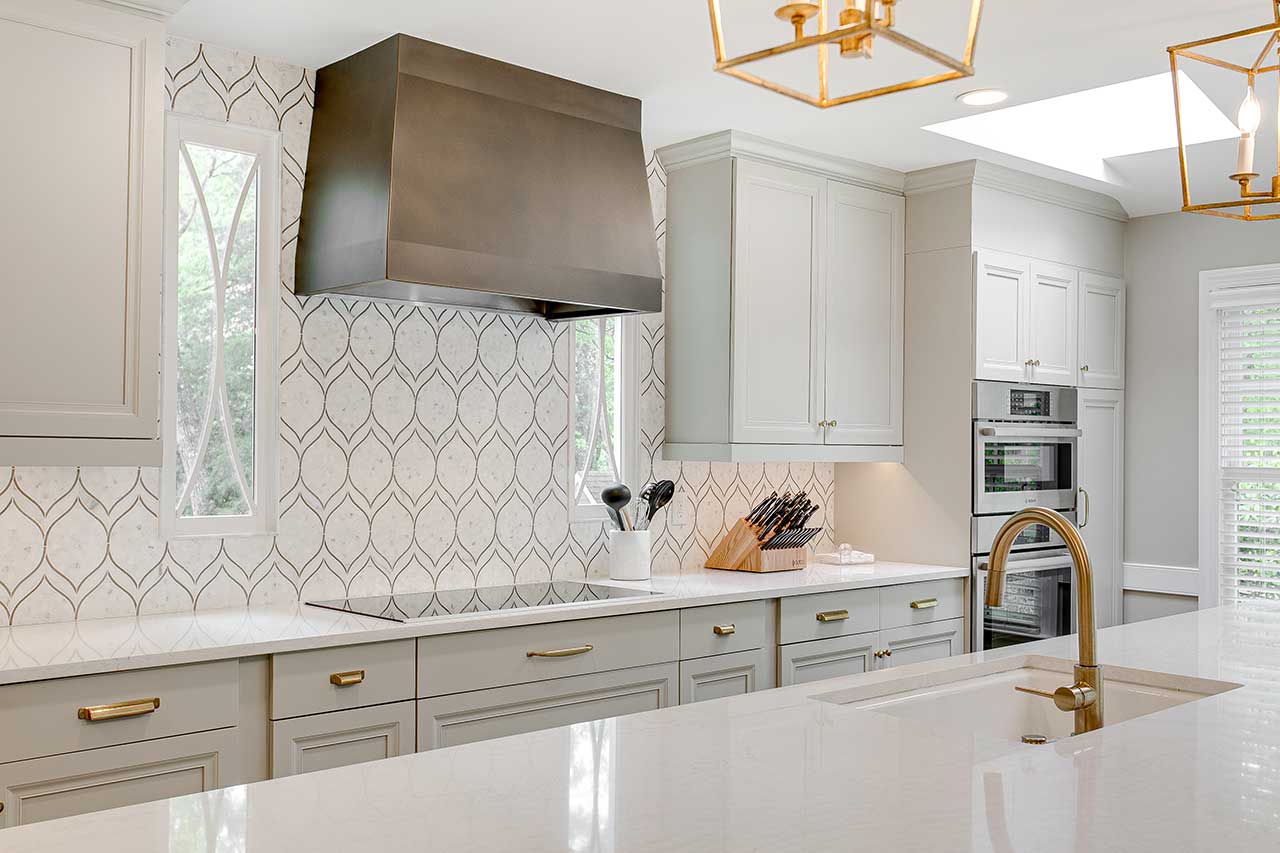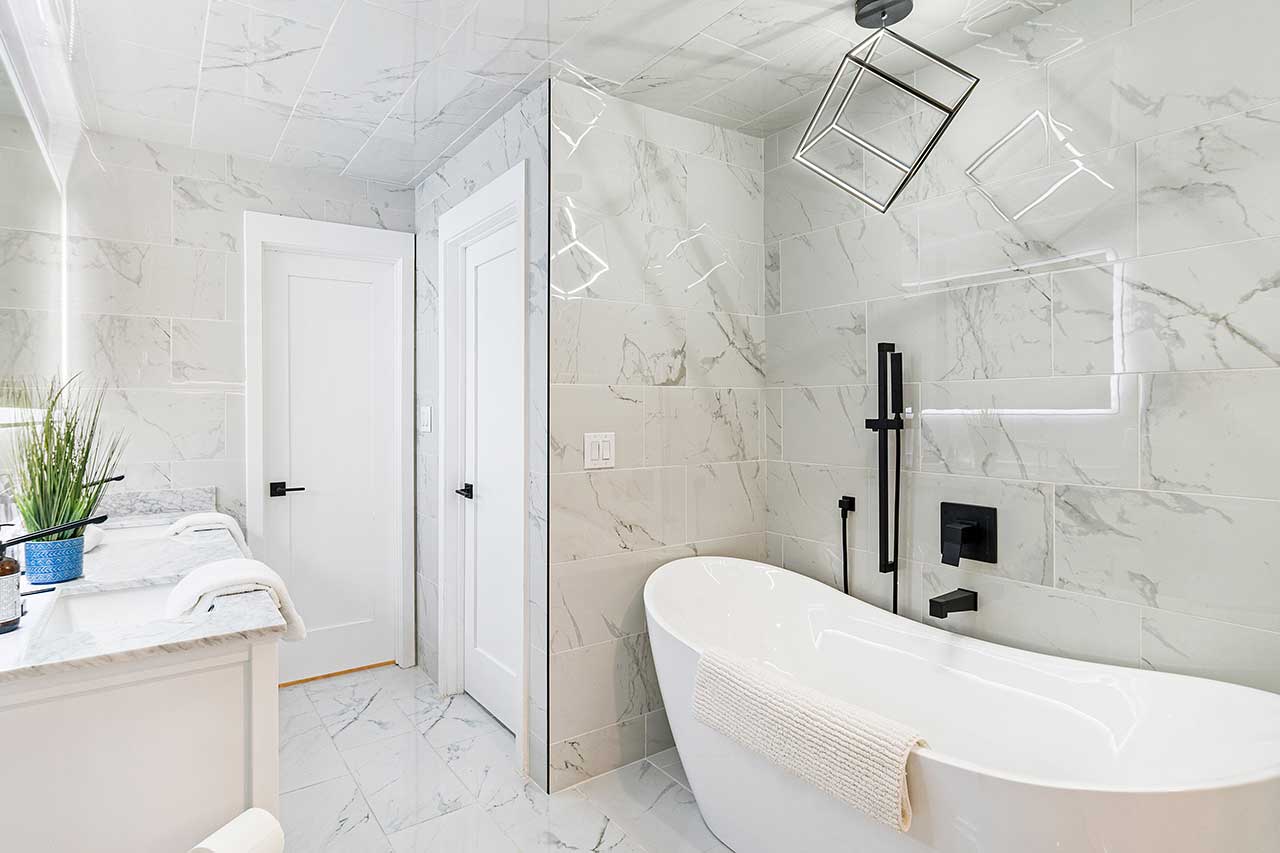

Left image: Photo: Allison / Adobe Stock
Right image: Photo: Bryan / Adobe Stock
Porcelain and ceramic tiles are often considered one and the same. However, there are significant differences in each tile’s porosity and makeup. Though both are made of clay and baked in a kiln, that’s where their similarities end. Porcelain is harder and more stain-resistant but more costly and not well-suited to DIY jobs, whereas ceramic is more porous and affordable.
In this article:
- What Are Porcelain Tiles?
- What Are Ceramic Tiles?
- Appearance
- Cost
- Upkeep
- Durability
- Installation
- Is Porcelain or Ceramic Better for Your Home?
- Porcelain and Ceramic vs. Other Options
What Are Porcelain Tiles?
Porcelain tile is a type of ceramic tile that’s made from porcelain clay and fired at high temperatures. It’s known for its durability, resistance to wear and tear, and ability to withstand moisture. Porcelain tiles are generally denser and less porous than other types of ceramic tiles, making them resistant to stains and easier to clean.
Like all materials, there are pros and cons to porcelain tile. One of the most notable drawbacks is that it isn’t suitable for DIY installation. However, you can use porcelain for various applications, including flooring, countertops, and backsplashes. Porcelain tiles are available in a wide range of colors, sizes, and styles, making them a popular choice for home renovations and new construction projects.
What Are Ceramic Tiles?
There are two main types of ceramic tiles: glazed and unglazed. Glazed ceramic tiles have a glossy finish and are often used on walls and countertops because they’re easy to clean. Unglazed ceramic tiles have a matte finish and are often used on floors because they’re more slip-resistant. Ceramic tiles are relatively inexpensive and easy to install, making them a popular choice for home renovations and new construction projects.
Consult with a Tile Installation ProfessionalAppearance
They can come in different colors, textures, and designs. The main difference is in their quality and durability. Both come in countless colors and textures, such as matte, terra-cotta, gloss, high-gloss, strutturato, brushed, wood-like, and more. Handmade tile that’s custom painted is another beautiful option that makes unique flooring and backsplashes.
| Porcelain Tiles | Ceramic Tiles |
|---|---|
| Often unglazed | More color and design options available |
| Color of the glaze tends to match the clay | Glazed |
| Available in glossy or matte | Wall tiles are glossy and have a thin, glass-like glaze |
| Floor tiles tend to be textured and have a matte glaze (if any) | Floor tiles are usually textured and have a matte glaze |
| Some made to look like other materials, such as wood, fabric, or glass | Color is only on the surface of the tile |
| Color goes right through the tile |
Porcelain Tiles
Porcelain tiles are often, but not always, unglazed. If a glaze is present, it’s usually very similar in color to the clay beneath. Plus, the color on porcelain goes all the way through the tile, so if you chip a tile, you’ll still see the same design and color beneath, not the exposed clay. While plain color is common, porcelain is available in a range of designs and is often made to mimic other materials. Common materials include wood, fabric, and glass.
Ceramic Tiles
Ceramic tiles are available in more designs and colors than porcelain, and it’s the most popular material for custom hand-painted tiles. Ceramic is always glazed, with wall tiles usually having a smooth, glossy finish and floor tiles having a matte glaze and textured surface. The color of ceramic tiles is only on the surface, so if you chip one, you’ll see the exposed clay beneath.
Cost
In general, porcelain tiles are more costly than ceramic. However, hand-painted ceramic tiles can cost as much as $100 per square foot.
| Porcelain Tiles | Ceramic Tiles |
|---|---|
| $4 – $8 per sq. ft. | $3 – $4 per sq. ft. |
Porcelain Tiles
Porcelain costs about 60% more than ceramic, or $4 to $8 per square foot.
Ceramic Tiles
Standard residential-grade glazed tiles cost between $3 and $4 per square foot. Based on this figure, a standard ceramic countertop costs about $480 to $1,600.
Consult with a Tile Installation ProfessionalUpkeep
The average cost to repair ceramic or porcelain tile is around $450, with the typical range being between $230 and $660.
| Porcelain Tiles | Ceramic Tiles |
|---|---|
| Harder to repair | Must be sealed |
| Don’t usually require sealing | Easy to remove and repair |
Porcelain Tiles
Porcelain is harder to fix than ceramic because it’s a harder material that’s much more challenging to work with. This type of tile is more challenging to cut and shape than ceramic. However, repairs in this type of tile don’t usually require sealing because the material is so dense and already non-porous.
Ceramic Tiles
Ceramic tile is easier to work with and, therefore, easier to fix. The tiles are comparatively easy to remove, cut, and repair. It’s important to remember that any ceramic repairs or cracked or crazed tiles require sealing because they’re not waterproof. Reglazing ceramic costs approximately $150 to $2,000, depending on how many square feet of tile need treatment.
Durability
Each tile differs in its ability to handle foot traffic, moisture, and impacts. For more information, check out the complete guide to ceramic tile grades, with level one being the weakest and five the strongest.
| Porcelain Tiles | Ceramic Tiles |
|---|---|
| Highly scratch-, chip-, and stain-resistant | Range in strength grades 1–5, so more durable versions are available |
| Resist spills well | Glazed versions have higher level of protection against wear and tear |
| Good-quality versions can last for over 20 years | Can last 10 – 20 years |
| Resistant to acids, heat, and UV rays | Lower-grade versions chip and scratch more easily |
| Strong as grade 5 ceramic | Absorb spills and stains faster |
| Less likely to crack when exposed to extreme heat | Heat-resistant but not heatproof |
| Non-porous, so has a very low water absorption rate | Extreme heat can damage the surface and cause it to crack |
| High water absorption rate due to its porosity |
Porcelain Tiles
Porcelain is tough and durable. Because of its density, porcelain is non-porous, so it doesn’t easily absorb water, making it a popular choice for wet areas such as bathrooms and kitchens. It’s also heat- and damage-resistant and isn’t likely to chip, stain, or scratch.
Ceramic Tiles
Ceramic tile is less durable than porcelain but still a tough material. There are four grades, with one being the weakest and four being the strongest and on par with porcelain. Glazed tiles are more resistant to water and stains than unglazed ones, but if used in a wet area like a bathroom, ceramic tiles need sealing immediately if they chip or crack or the glaze starts to crackle.
Installation
The cost to install ceramic or porcelain tile averages at $1,750 per project. The typical range is between $870 and $2,700. Low-end jobs can be as affordable as $500, and high-end jobs cost up to $5,000. To find out how many tiles you’ll need for your upcoming project, use our tile calculator.
| Porcelain Tiles | Ceramic Tiles |
|---|---|
| Not easy for DIY | Easier to DIY jobs |
| Difficult to work with | Easy to work with |
| Require a diamond saw to cut because of extreme hardness | Can be cut with a standard tile saw |
Porcelain Tiles
Porcelain requires professional installation as it’s harder, heavier, and more challenging to work with than ceramic. You’ll need to hire a local tile contractor to get the job done. The cost of labor is around $60 to $120 per hour. Applying 100 square feet of tile takes around 13 hours, which results in about $800 to $1,500 in labor. Porcelain is difficult to cut with anything but a diamond saw and fit because the tile is hard.
Ceramic Tiles
Ceramic tiles are easier to install than porcelain and are suitable for DIY installation if you have the time and the right skills and supplies. Although you’ll likely get a better end result if you hire a local ceramic tile installer. The cost of laying ceramic tile is around $60 to $100 per hour. Installing 100 square feet of tile requires 13 hours, resulting in about $800 to $1,300 in labor. Basic ceramic wall tile installation is easier than porcelain because the tile is easier to cut and install than porcelain. Ceramic tile is softer and cuts with a standard saw.
Need a Pro for Your Tile Installation?Is Porcelain or Ceramic Better for Your Home?
Which material is best for your home depends on a range of factors, including where you want to install it, your budget, and whether you’re DIY-ing it or planning to hire a pro.
| Factors | Porcelain Tiles | Ceramic Tiles |
|---|---|---|
|
Appearance |
Often unglazed; color goes right through tile | Always glazed; available in more colors and designs |
|
Cost |
$4 – $8 per sq. ft. | $3 – $4 per sq. ft. |
|
Upkeep |
Harder to repair; sealing not required | Must be sealed; easy to repair |
|
Durability |
Durable, non-porous, heat- and damage-resistant | Less durable; water-resistant |
|
Installation |
More difficult to DIY | Easier to DIY; easier to cut |
Kitchen Floors
The best tile for kitchen floors is a toss-up. Porcelain is the costlier option but requires less upkeep and stress over spills and stains. It’s up to the homeowner what they prefer. Ceramic is a more affordable option but requires more frequent upkeep.
The pros and cons of porcelain tiles and ceramic tiles differ when you examine them in different categories. If you want a wood floor but with the sturdiness and non-porous nature of porcelain, you can get a wood-look tile floor. Porcelain wood tile flooring costs approximately $1,500 to $12,000, depending on the quality of the tile and the size of the area.
Bathroom Walls
The best tile for your bathroom and shower walls is porcelain. It’s highly water-resistant and made to handle wet and humid conditions. Tiling a shower or bathroom costs around $450 to $1,000, depending on the tile you choose. For more information, check the guide on what to expect with your tiling project.
Countertops and Sinks
A good material for countertops is either sealed ceramic or porcelain. Though porcelain is the stronger material, sealed ceramic can also work as an excellent countertop because it’s strong, attractive, and durable. The same rule goes for sinks because they require a water-resistant material.
Porcelain and Ceramic vs. Other Options
The cost to install flooring with different materials will vary because each project is unique. For more detailed information, explore these tile basics.
| Material | Pro | Con |
|---|---|---|
|
Porcelain |
As hard as granite | Expensive |
|
Ceramic |
Affordable | Not great ROI for less expensive versions |
|
Vinyl |
Versatile | Low-quality grades can look fake |
|
Natural Stone |
Good ROI | Varied levels of durability and porosity |
|
Laminate |
Less expensive wood alternative | Not good for wet areas |
|
Linoleum |
Eco-friendly | Can turn yellow when exposed to sunlight |
|
Glass |
Recyclable | Slippery |
|
Terra-Cotta |
Attractive natural variation | Porous |
 Tile Counters Break up the Monotony
Tile Counters Break up the Monotony  Best Bathroom Flooring
Best Bathroom Flooring  Best Shower Flooring Options
Best Shower Flooring Options  How To Clean Tile Floors
How To Clean Tile Floors  Cheap Tile Flooring Buying & Installation Guide
Cheap Tile Flooring Buying & Installation Guide 

Are You Familiar With This Topic? Share Your Experience.